There were two kinds of roman games: ludi scaenici and ludi circenses. If at first the games of the early Roman republic had religious significance, then later the ‘secular’ games were purely for entertainment, some lasting a fortnight.
The theatrical Festivals (ludi scaenici)
The ludi scaenici, the theatrical performances, were hopelessly overwhelmed by the ludi circenses, the circus games. Far fewer festivals saw theatre plays than circus games.
For the spectacular events in the circus drew far greater crowds. This is also shown in the sheer scale of the structures built to house the audiences.
The playwright Terence (185-159 BC) tells of a festival held in honour of the deceased Lucius Aemilius Paulus in 160 BC. Terence’s comedy The mother in law was being staged and all was going well, when suddenly someone in the audience was heard saying that the the gladiatorial fights were about to begin. Within minutes his audience had disappeared.
The theatre plays were merely seen as an accompaniment to the ludi circences, although it needs to be said, that many Romans indeed ardent theatre-goers.
Perhaps as they were seen as more worthy, less populist, the theatrical performances were only staged for the most important festivals of the year.
The floralia for instance saw the staging of plays, some of which were of a sexual nature, which can be explained by the fact that the goddess Flora was understood to have very loose morals.
The Circus Games (ludi circenses)
Ludi circenses, the circus games, took place in the marvellous circuses, and amphitheatres and were breathtakingly spectacular, though also gruesome events.
Chariot Racing

Roman passions ran high when it came to chariot racing and most supported one of the teams and its colours, – white, green, red or blue. Though passions could often boil over, leading to violent clashes between opposing supporters.
There was four different parties (factiones) to support; the red (russata), the green (prasina), the white (albata) and the blue (veneta).
Emperor Caligula was a fanatical supporter of the green party. He spent hours in their stables, amongst the horses and charioteers, he even ate there.
The public adored the top drivers. They were quite literally comparable to modern day sports stars. And, quite naturally, there was a huge amount of betting surrounding the races. Most drivers were slaves, but there was also some professionals among them. For a good driver could win vast sums. The chariots built purely for speed, as light as possible, and were drawn by teams of two, four or sometimes even more horses. The larger the teams of horses, the greater the expertise of the driver needed to be. Crashes were frequent and spectacular.
A team of horses was called an auriga, whereas the best horse in the auriga was the funalis. The best teams were therefore those, in which the auriga co-operated to best effect with the funalis. A two-horse team was called a biga, a three-horse a triga and a four-horse team was a quadriga.
The charioteers drove standing upright in their chariots, wearing a belted tunic in the colours of his team and a light helmet.
The full length of the race consisted normally of seven laps around the stadium, totalling about 4000 metres when measured in the Circus Maximus in Rome. There was incredible tight turns at either end of the track, around the narrow isle (spina) which divided the arena. Each end of the spina would be formed by an obelisk, which was called the meta. The skilled charioteer would try to corner the meta as tightly as possible, sometimes grazing it, sometimes crashing into it.
The arena being sand, there was no lanes – and there was nothing which one could describe as rules. The first to complete the seven rounds was the winner, that was it. Between start and finish pretty much anything was allowed. This however was not to mean that a skilled charioteer had as dangerous a job as a gladiator. Some of the starts achieved over a thousand victories and some horses are reported to have won several hundred races.
Gaius Appuleius Diocles was perhaps the greatest star of them all. He was a quadriga charioteer who is said to have contested 4257 races. Of those he finished second 1437 times and won 1462.
In the reign of the horse-crazed Caligula, one of the great gladiator names of the day was Eutyches. His many wins made him a close friend of the adoring emperor, who gave him no less than two million sesterces in rewards and prizes.
Chariot racing was indeed a frequent affair in Rome on race day. Under the rule of Augustus, one might see up to ten or twelve races in a day. From Caligula onwards there would even be as many as twenty-four a day.
Gladiatorial Games (munera)
It was undoubtedly the ludi circenses of the amphitheatres which have given the Romans bad press over time.
For people of our modern age, it is difficult to understand what could have motivated the Romans to watch the cruel spectacle of men fighting each other to death.
Roman society was not inherently sadistic. The gladiatorial fights were symbolic in nature. Although there is little doubt that the mob baying for blood was little aware of the finer symbolical points. A Roman mob will have differed little from a modern-day lynch mob or a horde of soccer hooligans.
But to most Romans the games will have been more than mere bloodlust. There was a certain magic about the roman games which their society appeared to understand.
Entry to the roman games was free. It was a citizen’s right to see the games, not a luxury.
Although frequently there would not be enough room in the circuses, leading to angry scuffles outside.
People would in fact begin to queue throughout the night to make sure of a place in the circus.
Much like in modern day sports events, there is more to the game than just the event itself, there is the characters involved, the personal drama as well as technical skill and determination. Just as soccer fans do not just go to see 22 men kick a ball, and a baseball fan does not just go to watch a few men through a little ball about, so did the Romans not just sit and watch people being killed. It is difficult to comprehend today, yet there was a different dimension to the roman games in their eyes.
The tradition of gladiatorial combat was, it appears, not a Roman development at all. Far more the native tribes of Italy, in particular the Etruscans seemed to have brought about this gruesome idea.
In primitive times it was a custom to sacrifice prisoners of war at the burial of a warrior. Somehow, as a means of making the sacrifice less cruel, by granting at least the victors a chance to survive, these sacrifices were gradually transformed into fights between the prisoners.
This non-Roman tradition appears to have finally come to Rome from Campania.
The first recorded gladiatorial combat in Rome was held to honour the deceased Junius Brutus in 264 BC. Three pairs of slaves fought each other that day. They were called bustuarii. This name refers to the Latin expression bustum which means ‘tomb’ or a ‘funeral pyre’. Such bustuarii appeared to be armed as what later were known as Samnite gladiators, with a rectangular shield, a short sword, a helmet and greaves.
(According to the historian Livy, it was supposedly it was the Campanians who in 310 BC to mock the Samnites, whom they had just defeated in battle, had their gladiators dress up as Samnite warriors for the fight.)
This first fight in Rome took place in the Forum Boarium, the meat markets on the banks of the Tiber. But the fights soon became established in the Forum Romanum in the very heart of Rome itself.
At a later stage seats were placed around the forum, but at first one merely would find a place to sit or stand and watch the spectacle, which at that time was still understood to be part of a ceremony, not entertainment.
This events became known as munera which meant ‘debt’ or ‘obligation’. They were understood as obligations rendered to the dead. With their blood the manes the spirits of the deceased ancestors were satisfied.
Often these bloody events would then be followed by a public banquet in the Forum.
One can find a belief in some parts ancient of the ancient world, hard to understand by modern man, that blood sacrifices to the dead could somehow elevate them, granting them a form of deification. Hence many patrician families, who had made such blood sacrifices to the dead in form of the munera, went on to invent for themselves divine ancestry.
In any case, somehow these early gladiatorial fights gradually became celebrations of other sacred ceremonies, apart from merely funeral rites.
It was close to the end of the republican era of Rome at which the gladiatorial fights largely lost their meaning as a rite of some spiritual significance.
Their sheer popularity led to their gradual secularization. It was inevitable that something which was so popular would become a means of political propaganda. Thus more and more rich politicians hosted gladiatorial games in order to make themselves popular. With such blatant political populism it wasn’t remarkable that the gladiatorial fights turned from a ritual into a show.
The senate tried its best to curb such developments, but didn’t dare to enrage the populace by forbidding such political sponsorship.
Due to such senatorial resistance it took until 20 BC before Rome had its first stone amphitheatre (built by Statilius Taurus; the theatre was destroyed in the Great Fire of Rome in AD 64).
As the rich more and more intensified their efforts to dazzle the audience, the plebeians became ever more choosy. Spoilt by ever more fanciful spectacles the mob soon demanded more. Caesar even clad his gladiators in armour made of silver at the funeral games which he held in honour of his father ! But even this soon no longer excited the crowd, once others copied it and it was even replicated in the provinces.
Once the empire was ruled by the emperors, the essential use of the Roman games as a propaganda tool didn’t cease. It was a means by which the ruler could show his generosity. The Roman games were his ‘gift’ to the people. (Augustus matched an average of 625 pairs in his spectacles. Trajan had no less than 10’000 pairs fight each other in his Roman games held to celebrate his victory over the Dacians.)
Private Roman games still continued to be held, but they could not (and no doubt should not) rival the spectacles laid on by the emperor. In the provinces naturally, the roman games remained privately sponsored, but in Rome itself such private spectacles were left to the praetors (and later to the quaestors) during the month of December when the emperor did not host Roman games.
But if it was in Rome itself, or in the provinces, Roman games were now no longer dedicated to the memory of the deceased but in honour of the emperor.
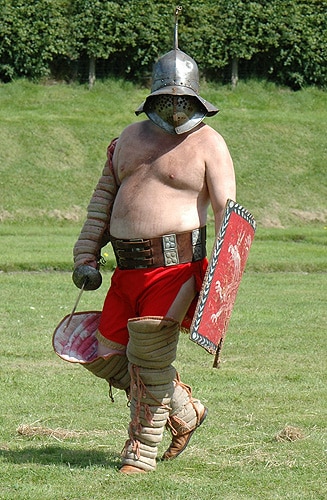
The games and their requirement of a large amount of gladiators brought about the existence of a new profession, the lanista. He was the entrepreneur who supplied the wealthy republican politicians with the troops of fighters. (Later under the emperors, independent lanistae only really supplied provincial circuses. In Rome itself they were only lanistae by name, as in fact the entire industry supplying the circuses with gladiators was by then in imperial hands.)
He was the middle man who made money by buying healthy male slaves, training to be gladiators and then sold or rented them to the host of the games.
The Roman paradoxical feelings towards the games are perhaps best shown in their view of the lanista. If Roman social attitudes looked down upon any kind of person related to ‘showbusiness’, then this certainly counted for the lanista. Actors were seen as little more than prostitutes as they ‘sold themselves’ on the stage.
Gladiators were seen as yet even lower than that. Therefore the lanista was much seen as a kind of pimp. It was he who reaped the bizarre hatred of the Romans for having reduced men to creatures marked out for slaughter in the arena – gladiators.
In a strange twist, such loathing was not felt for rich men who might indeed act as lanista, but who’s main income was in fact generated elsewhere.

Gladiators were always dressed up to resemble barbarians. Whether they really were barbarians or not, the fighters would bear exotic and purposely strange armour and weapons. The more far-fetched the weapons and armour were, the more barbarous the gladiators appeared to Roman eyes. This also made the fights a celebration of Rome’s empire. The Thracian and the Samnite all represented the very barbarians Rome had defeated. So too the hoplomachus (Greek Hoplite) was a vanquished foe. Their fighting it out in the arena was living confirmation of Rome being the very centre of the world it had conquered. The murmillo is sometimes called the Gaul, so there might be a connection. Apparently his helmet was deemed ‘Gallic’. This may therefore continue the imperial connection.
But generally he is seen as a mythical fish- or sea-man. Not least due to the fish supposedly set upon the crest of his helmet. He was traditionally paired with the retiarius, which makes perfect sense, as the latter is the ‘fisherman’ who seeks to catch his opponent in a net. Some suspect that the murmillo may be derived from the mythical Myrmidons were led by Achilles at the Battle of Troy. Then again, given that the ancient Greek for ‘fish’ is ‘mormulos’, one tends to come full circle. The murmillo therefore remains a bit of an enigma.
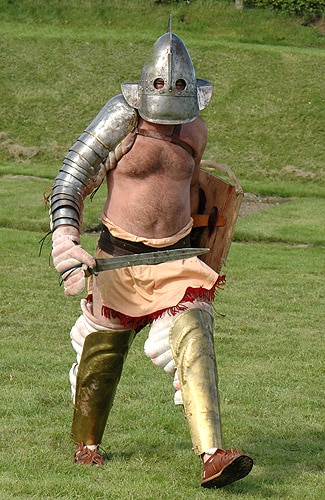
The smooth, almost spherical helmet of the secutor is believed to have been virtually ‘trident-proof’. It offered no angles or corners for the prongs of the trident to get a hold of. This seems to suggest that the fighting style of the retiarius was to stab at the face of his opponent with his trident.
The safety of the secutor came at a price though. His eye holes allowed him very little visibility. A fast moving, dexterous opponent might succeed in escaping from his limited field of vision altogether. Should this happen it would most likely be fatal for the secutor. His fighting style will therefore have depended very much on keeping his eyes glued upon his foe, determined to face him directly and adjusting his head and position with even the slightest of his opponent’s movements.
(Note: the secutor’s helmet seems to have evolved over time. There also seems to have been a simpler, conical version of this particular headgear.)
Types of Gladiators
| Andebate | limbs and lower torso protected by mail armour, chest and back plate, large vizored helmet with eye holes | |
| Dimachaerus | sword fighter, but using two swords, no shield (see below 1:) | |
| Equestrian | armoured riders, chest plate, back plate, thigh armour, shield, lance | |
| Essedarius | fights from war chariots | |
| Hoplomachus (he later substituted the Samnite) | Very similar to the Samnite, but with a larger shield. His name was the Latin term for a Greek hoplite. | |
| Laquearius | most likely much like the Retiarius, but using a ‘lassoo’ instead of a net and most likely a lance instead of a trident | |
| Murmillo/Myrmillo | large, crested helmet with vizor (with a fish on its crest), little shield, lance | |
| Paegniarius | whip, club and a shield which is fixed to the left arm with straps | |
| Provocator | like Samnite, but with shield and lance | |
| Retiarius | trident, net, dagger, scaled armour (manica) covering left arm, projecting shoulderpiece to protect the neck (galerus) | |
| Samnite | medium shield, short sword, 1 greave (ocrea) on left leg, protective leather bands covering wrists and knee and ankle of right leg (fasciae), large, crested helmet with vizor, small chest plate (spongia) (see below 2:) | |
| Secutor | large, almost spherical helmet with eye holes or large crested helmet with vizor, small/medium shield | |
| Tertiarius | substitute fighter (see below 3:) | |
| Thracian | curved short sword (sica), scaled armour (manica) covering left arm, 2 greaves (ocreae) (see below 4:) |
The fighters’ equipment as it is mentioned above is not based on an absolute rule. Equipment could vary to a point. A retiarius for example did not necessarily always have a manica on his arm, or a galerus on his shoulder. The above descriptions are merely rough guidelines.
Gladiator Footnotes:
- The Dimachaerus was possibly, so it is thought, not a particular type of gladiator, but a gladiator of the sword-fighting variety who instead of a shield, fought with a second sword.
- The Samnite disappeared roughly at the end of the republican era and appears to have been substituted by the Hoplomachus and the Secutor.
- The Tertiarius (or Suppositicius) was quite literally a substitute fighter. In some cases it could be that three men were matched against each other. The first two would fight, only for the winner to be met by the third man, this third man would be the tertiarius.
- The Thracian gladiator first appeared around the time of Sulla.
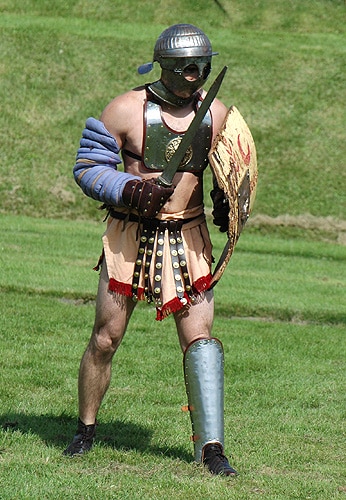
The staff of the lanista which looked after the gladiatorial school (ludus) was the familia gladiatoria. This expression, cynical as it clearly became, actually stemmed from the fact that in its origins they would be the household slaves of the lanista. With the schools becoming large, ruthless, professional institutions, this name no doubt became somewhat of a cruel joke.
The teachers at a gladiatorial school were called doctores. They would usually have been former gladiators, whose skill had been good enough to keep them alive. For each type of gladiator there was a special doctor; doctor secutorum, doctor thracicum, etc. At the opposite end of the scale of experience to the doctores was the tiro. This was the term used for a gladiator who had not yet had a fight in the arena.
Though despite all their training. Gladiators though were mediocre soldiers. There were occasions on which gladiators were recruited to fight in battle. But they clearly were no match for real soldiers. Gladiatorial fencing was a dance, made for the arena, not for the battle field.
At the event itself, the pompa, the procession into the arena, was perhaps the last remainder of what once was a religious ritual.
The probatio armorum was the checking of the weapons by the editor, the ‘president’ of the roman games. Often this would be the emperor himself, or he would bestow the checking of the weapons to upon a guest he sought to honour.
This checking that the weapons were truly real, will most likely have been done in order to assure the public, many of whom may have placed bets on the outcome of a fight, that all was in order and no weapons had been tampered with.
Not merely the appreciation of the spectacle as such, but also the knowledge of the details surrounding the gladiatorial art seem to have largely been lost by today.
The audience was not interested in mere blood. It sought to observe the technical subtleties, the skill of trained professionals when watching the fights.
It appears that much of the interest in the fights lay in the way the various fighters and their different fighting techniques were matched. Certain matches were deemed incompatible and hence were not staged. A retiarius for example never fought another retiarius.

Generally a fight would be between two contestants, a so-called paria, but sometimes a fight might be made up of two teams pitched against one another.
Were it a single paria, or a team effort, similar types of gladiators did not normally fight each other. Contrasting types of fighters were matched, though always an attempt was made to assure a reasonably fair pairing.
One gladiator might only be lightly armed with little to nothing to protect him, whereas the other might be better armed, but restricted in his movements by his equipment.
Therefore each gladiator, to some extent or another, was either too heavily or too lightly armed.
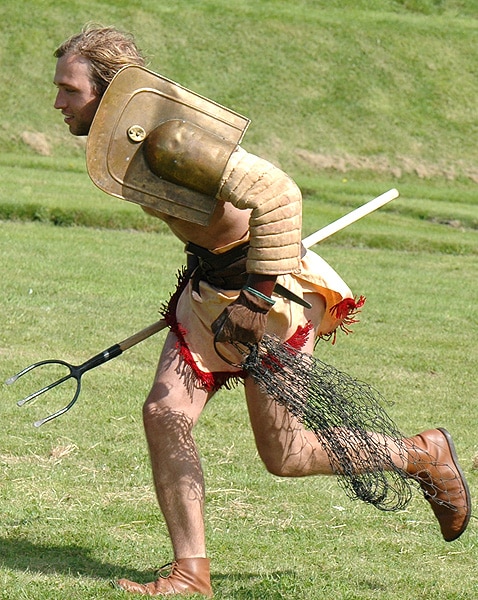
Meanwhile to assure that the gladiators actually showed sufficient enthusiasm, attendants would stand by with red-hot irons, with which they would poke any fighters who didn’t show enough ardour.
It was largely left to the crowd to signify whether a wounded and downed gladiator should be finished off by his opponent. They did so by waving their handkerchiefs for a release, or giving the ‘thumbs down’ signal (pollice verso) for death. The deciding word was that of the editor, yet as the entire idea of holding such roman games was to win popularity the editor would rarely go against the will of the people.
The most dreaded of combats for any gladiator must have been the munera sine missione. For it is in fact true that quite often both gladiators would leave the arena alive. As long as the crowd was content that the two fighters had tried their best and had entertained them with a good show, it might often not demand the death of the loser. It of course also occured that the better fighter might, only through bad luck come to lose a fight. Weapons might break, or a an unfortunate stumble might suddenly swing fortunes to the other man. In such cases, audiences did not seek to see blood.
Missus was the term for a defeated gladiator being given a reprieve. He wasn’t killed, but sent back to his barracks, where he would train for his next fight. But ‘sine missione’ meant ‘without reprieve’. Such fights were indeed to the death, no matter how valiant the combatants had fought. Emperor Augustus did indeed forbid such fights, in which bravery could not save a man. He outlawed them as cruel. But after his death they would return, since their presence added to the very thing the game’s organizers sought to create; variety.

Few gladiators fought without helmets. The most well known was is undoubtedly the retiarius.
Though this lack of a helmet proved to the disadvantage of the retiarii during the reign of Claudius. Known for his cruelty he would always demand the death of a vanquished retiarius so that he could observe his face as he was killed.
This however was a crass exception. Gladiators were otherwise seen as absolutely anonymous entities. Even the stars among them. They were living abstract symbols in the struggle for life in the arena and not seen as human individuals.
Another well known class of gladiators not to wear helmets were women. There were indeed female gladiators, although they seem only to have been used in order to further add to the variety of the Roman games, rather than as a mainstay comparable to the male gladiators. And it was hence, in this role as an additional facet to the Roman games, that they fought without helmets, to add feminine beauty to the slaughter of the circus.
Much like in horse racing where there was so-called factions (defined by their racing colours) in the gladiatorial circus there was much the same passion for particular sides. Mostly sympathies were divided for the ‘great shields’ and the ‘little shields’.
The ‘great shields’ tended to be defensive fighters with little armour to protect them. Whereas the ‘little shields’ tended to be more aggressive fighters with only small shields to ward off attacks.
The little shields would dance around their opponent, seeking a weak spot at which to attack. The ‘great shields, would be far less mobile, waiting for the attacker to make a mistake, waiting for their moment when to lunge. Naturally a prolonged fight was always in favour of the ‘great shield’, for the dancing ‘little shield’ would grow tired.
Romans spoke of water and fire when talking of the two factions. The great shields being the calm of water, waiting for the flickering fire of the small shield to die down.
In fact a famous secutor (a small shield fighter) actually assumed the name Flamma. It is also most likely that the retiarius (as well as the related laquearius), although fighting without a shield would have been classed as a ‘great shield’ due to his fighting style.
Along with the factions which the people might back, there was of course also the stars. These were famous gladiators who had proven themselves time and time again in the arena.
A secutor named Flamma was awarded the rudis four times. Still he chose to remain a gladiator. He was killed in his 22nd fight.
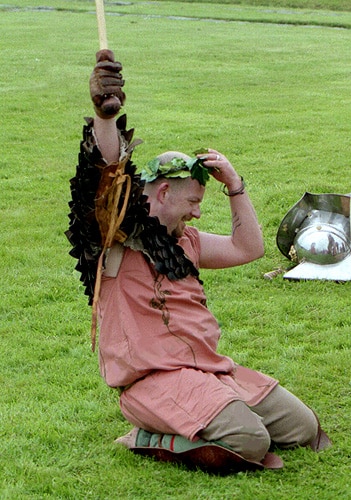
Hermes (according to the poet Martial) was a great star, a master of swordsmanship.
Other famous gladiators were Triumphus, Spiculus (he received inheritances and houses from Nero), Rutuba, Tetraides. Carpophorus was a famous bestiarius.
The greater a star became the more his loss would be felt by his master, if he was set free. Emperors were hence at times reluctant to grant liberty to a fighter and did so only if the crowd insisted.
There was no absolute as to what a gladiator would have to do in order to win his freedom, but as a rule of thumb one might say that a gladiator won five fights, or especially distinguished himself in a particular fight, he won the rudis.
In the school, the rudis was the name used for the wooden sword with which the gladiators would train. But in the arena, the rudis was the symbol of freedom. If a gladiator was given a rudis by the editor of the games it meant he had earned his freedom and could leave as a free man.
The killing of a gladiator was to modern eyes a truly bizarre affair. It was far from the mere butchery of a man. Once the editor had decided that the vanquished fighter was to die, a strange ritual took over. Perhaps this was a left-over from the days in which the fight was still a religious rite. The defeated gladiator would offer his neck to the weapon of his conqueror, and would – as far as his wounds allowed him – take a position where he was bent on one knee, gripping the other man’s leg.
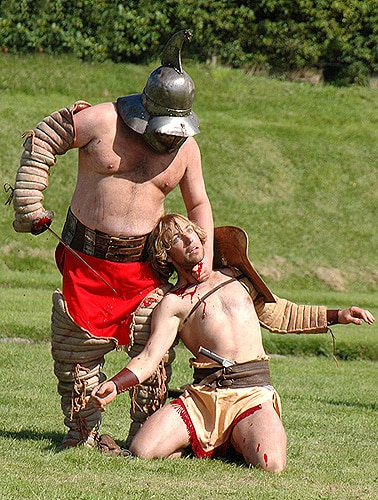
In this position he would then have his throat cut.
Gladiators would even be taught how to die at their gladiatorial schools. It was an essential part of the spectacle: the graceful death.
A gladiator was not to plead for mercy, he was not to scream as he was killed. He was to embrace death, he was to show dignity. More so, than just a mere demand by the audience it also appeared to be the wish of the gladiators to die gracefully. Perhaps there was a code of honour among these desperate fighting men, which made them die in such a fashion. It no doubt restored at least some of their humanity. An animal could be stabbed down and slaughtered. But only a human could die gracefully.
Though with the death of a gladiator the bizarre and exotic show was not yet over.
Two strange characters would enter the arena in one of the intervals, by which time several corpses might litter the floor. One was dressed as Hermes and carried a red-hot wand with which he would prod the corpses on the ground.
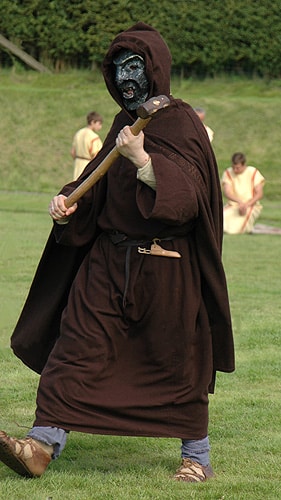
The second man was dressed as Charon, the ferryman of the dead. He bore with him a large mallet, which he would smash onto the skulls of the dead. Once again these actions were symbolical. The touch of Hermes’ wand was supposed to be able to bring the worst enemies together. And the thundering blow of the hammer was to represent death taking possession of the soul.
But no doubt their actions were also practical in nature. The searing hot iron would quickly establish if a man was indeed dead and not merely wounded or unconscious. What precisely happened if a gladiator should indeed be found out to be well enough to survive is unclear. Because one can’t help but suspect that the mallet which smashed in their skulls was meant to end whatever life was still left in them.
Once this was over the corpses would then be removed. The bearers, the libitinarii, might well carry them away, but it was also possible that they might drive a hook (the likes of which one hangs meat on) into the body and drag them out of the arena. Alternatively they might also be dragged out of the arena by a horse. Either way, they were awarded no dignity. They would be stripped and their corpses would be thrown into a mass grave.
The Wild Beast Hunts (venationes)
Adding a hunt to the munus was something which was introduced as a means by which to make the circus games yet more exciting, as toward the end of the republican era, the powerful vied for the favour of the public.
Suddenly it became important for a politician to know from where to purchase exotic wild beasts with which to dazzle audiences.
For the venationes wild animals were rounded up from all parts of the empire to be killed as part of the spectacle in the morning as a precursor to the gladiatorial contests in the afternoon.
Starving tigers, panthers and lions were let out of cages to be confronted in long and dangerous chases by armed gladiators.
Bulls and rhinoceroses were first brought to a rage, much like in a Spanish bullfight, before they were met their hunters.
For variety, animals were goaded to fight each other. Elephants versus bulls was a feature of Roman games in 79 BC.
There were also less spectacular hunts held in the circuses. In the festival known as the cerealia foxes with torches tied to their tails were hunted through the arena. And during the floralia mere rabbits and hares were hunted.
As part of the celebrations for the opening of the Colosseum in AD 80, no fewer than 5000 wild beasts and 4000 other animals met their death in one day.
It is also worth pointing out that the more noble beasts, like lions, elephants, tigers, etc. were only allowed to be used in the circuses of Rome. Provincial circuses need make do with wild dogs, bears, wolves, etc.
One also needs to add that the venatio was not at a mere slaughter of animals. Mere slaughter would not have been appreciated by Romans. The animals were ‘fought’ and they did stand a slight chance of being left alive or sometimes won the mercy of the audience. Most of all the costly noble beasts, which had been brought over great distances, a shrewd editor might well seek to preserve.
As for the men who took part in the hunts, these were the venatores and bestiarii. Among these there was specialized professions like the taurarii who were bullfighters, the sagitarii were archers, etc.
Most venatores would fight with a venabulum, a sort of long pike with which they could stab at the beast, whilst keeping themselves at a distance. These animal fighters strangely did not suffer the same grave social degradation as the gladiators.
Emperor Nero himself descended into the arena to fight a lion. He was either unarmed, or armed with merely a club. If this at first sounds like an act of courage, then the fact that the beast had been ‘prepared’ in advance of his entry quickly destroys that image. Nero faced a lion which had been made harmless and which posed no threat to him at all. Nonetheless the mob cheered him. Others though were less impressed.
In similar fashion emperor Commodus is also said to have descended into the arena to slay beasts previously made helpless.
Such occurrences were much frowned upon by the ruling classes which saw them as cheap tricks to gain popularity and beneath the dignity of office, which the position of emperor commanded.
Public Executions
Public executions of criminals also formed part of the circenses.
The perhaps most popular forms of such executions in the circus were spectacles which were mock plays and ended in the death of the leading ‘actor’.
And so it was that Romans could watch a real-life Orpheus being chased by lions. Or in a reproduction of the tale of Daedalus and Icarus, Icarus would be dropped from a great height to his death onto the arena floor, when in the story he fell from the sky.
Another such real-life play was the tale of Mucius Scaevola. a condemned criminal playing Mucius would, like the hero in the story, have to remain silent while his arm was terribly burnt. If he achieved it, he would be spared. Though if he screamed from the agony, he would be burnt alive, already being dressed in a tunic soaked in pitch.
As part of the opening of the Colosseum a play was held in which an unfortunate criminal, in the role of the pirate Lareolus was crucified in the arena. Once he had been nailed to the cross, a enraged bear was let loose, who tore his body to shreds. The official poet who described the scene went into great detail to describe how what alas was left of the poor wretch did no longer resemble a human body in any shape or form.
Alternatively, under Nero, the animals tore apart contingents of condemned and unarmed criminals: many Christians falling victim to Nero’s claim that they had started the Great Fire of Rome.
Christians featured on another gruesome occasion when illuminated his extensive gardens at night with the brightness of the human torches that were the burning bodies of Christians.
The ‘Sea Battles’ (naumachiae)
Perhaps the most spectacular form of combat was the naumachia, the sea fight. This would involve flooding the arena, or simply moving the show to a lake.
The first man to hold a naumachia appears to have been Julius Caesar, who went so far as to have an artificial lake created in order to have two fleets fight each other in a naval battle. For this no fewer than 10’000 oarsmen and 1000 marines were part of the show which was to reenact a battle between Phoenician and Egyptian forces.
The famous Battle of Salamis (480 BC) between the Athenian and the Persian fleets proved very popular and hence was recreated several times in the first century AD.
The greatest naumachia event ever was held under in AD 52 in celebration of the completion of a great construction project (a tunnel to carry water from Lake Fucine to the river Liris which took 11 years to build). 19’000 fighters met on two fleets of galleys on Lake Fucine. The battle was not fought to annihilation of one side, although considerable losses occured on either side. But the emperor judged both sides had fought bravely and so the battle could cease.
Circus Disasters
At times, the dangers of the circus were not only to be found in the arena.
Pompey organized a grandiose fight involving elephants in the Circus Maximus, which until the construction of the Colosseum, was often used to stage gladiatorial events. Iron barriers were to be put up as archers hunted the great beasts. But things got seriously out of control as the crazed elephants broke some of the iron barriers put up to protect the crowd. The animals were eventually driven back by the archers and succumbed to their wounds in the center of the arena. Utter disaster had just been averted. But Julius Caesar wasn’t to take any chances and later had a ditch dug around the arena in order to prevent similar disasters.
In AD 27 a wooden temporary amphitheatre at Fidenae collapsed, with perhaps as many as 50’000 spectators being involved in the disaster.
In response to this catastrophe the government introduced stringent rules, for example preventing anyone with less than 400’000 sesterces from staging gladiatorial events, and also listing minimum requirements for the structure of the amphitheatre.
Another problem were local rivalries. During Nero’s reign the games at Pompeii ended in disaster. Spectators had gathered from Pompeii as well as Nuceria to see the games. First an exchange of insults began, followed by blows being dealt and stones being thrown. Then a furious riot broke out. The spectators from Nuceria were fewer than those of Pompeii and hence fared far worse, many being killed or wounded.
Nero was furious at such behaviour and banned the games at Pompeii for ten years.
Pompeians however continued long after to boast of their deeds, scribbling graffiti on the walls which told of their ‘victory’ over the people of Nuceria.
Constantinople also had its fair share of crowd problems at the games. Most famously the riotous fans of the different parties at the chariot races. The supporters of the blues and those of the greens were fanatical militants. Politics, religion and sport combined into a dangerously explosive mixture. In AD 501 during the festival of Brytae, when the green attacked the blues in the Hippodrome, even the illegitimate son of emperor Anastasius was among the victims of the violence. And in AD 532 the Nika rebellion of the blues and greens in the Hippodrome almost overthrew the emperor. By the time it was over tens of thousands lay dead and a substantial part of Constantinople had burned down.

Historian Franco Cavazzi dedicated hundreds of hours of his life to creating this website, roman-empire.net as a trove of educational material on this fascinating period of history. His work has been cited in a number of textbooks on the Roman Empire and mentioned on numerous publications such as the New York Times, PBS, The Guardian, and many more.
